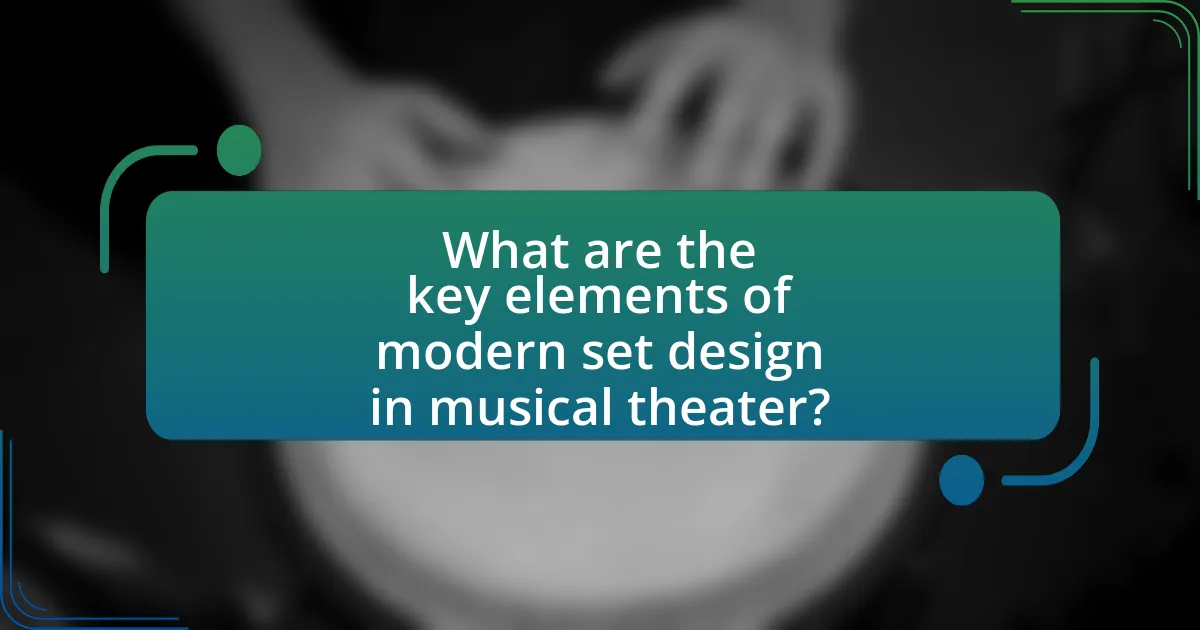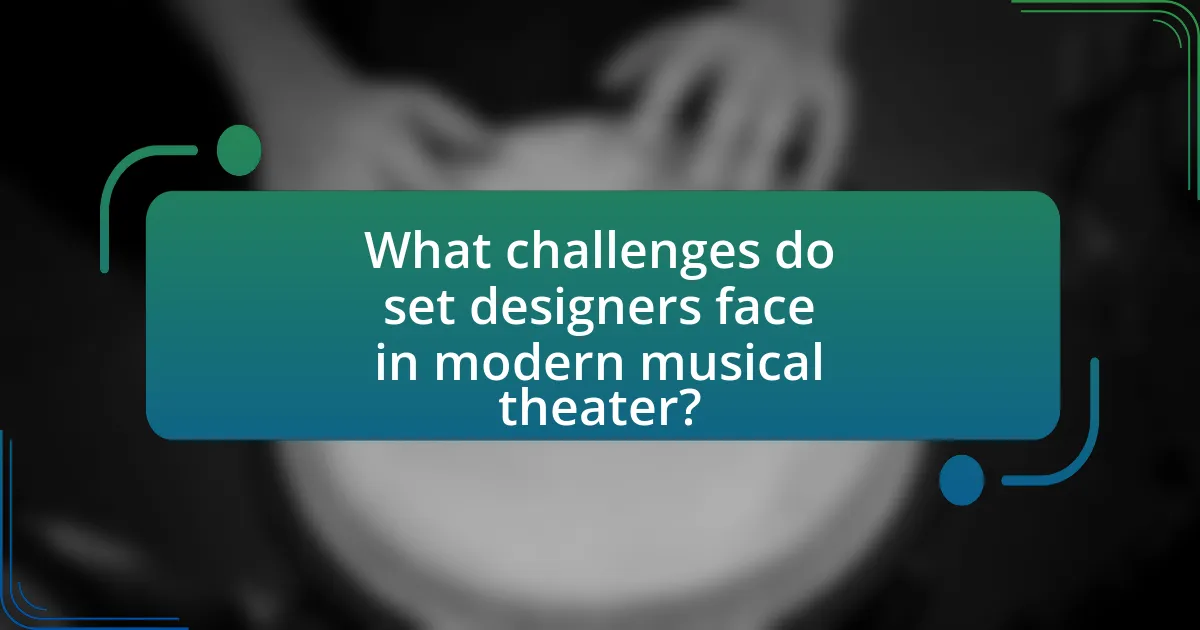The article examines the evolution of set design in modern musical theater, highlighting its transition from elaborate, static backdrops to dynamic, multifunctional environments that enhance storytelling. It discusses key influences on set design throughout the decades, including technological advancements and artistic movements, and emphasizes the importance of set design in character development and audience engagement. The article also explores contemporary trends such as minimalism, immersive environments, and the integration of digital technology, while addressing the challenges set designers face, including budget constraints and logistical issues. Additionally, it outlines best practices for aspiring set designers, emphasizing collaboration and the use of available resources for skill development.

What is the Evolution of Set Design in Modern Musical Theater?
The evolution of set design in modern musical theater has transitioned from elaborate, static backdrops to dynamic, multifunctional environments that enhance storytelling. In the early 20th century, set designs were often grand and ornate, focusing on realism and detailed craftsmanship, as seen in productions like “Show Boat” (1927). The mid-20th century introduced more abstract and minimalist designs, exemplified by “West Side Story” (1957), which utilized simple, suggestive elements to convey mood and setting.
In recent decades, technological advancements have further transformed set design, incorporating digital projections and automated scenery, as demonstrated in shows like “Hamilton” (2015), where the set adapts fluidly to the narrative. This shift reflects a broader trend towards immersive experiences, allowing for greater flexibility and creativity in staging. The integration of technology and innovative materials has made set design a crucial element in enhancing the overall theatrical experience, emphasizing the importance of visual storytelling in modern musical theater.
How has set design changed over the decades in musical theater?
Set design in musical theater has evolved significantly over the decades, transitioning from static, painted backdrops to dynamic, multi-dimensional environments. In the early 20th century, set designs primarily featured flat, two-dimensional scenery that relied heavily on painted backdrops and minimal props. By the 1960s and 1970s, advancements in technology and a shift towards more immersive storytelling led to the introduction of three-dimensional sets, movable pieces, and innovative materials, allowing for greater flexibility and creativity.
In recent decades, the integration of digital technology has further transformed set design, enabling projections and interactive elements that enhance the audience’s experience. For instance, productions like “The Lion King” and “Hamilton” utilize elaborate set designs that incorporate both physical and digital components, showcasing the trend towards hybrid designs that blend traditional craftsmanship with modern technology. This evolution reflects a broader trend in the performing arts towards creating more engaging and visually stunning theatrical experiences.
What were the key influences on set design in the early 20th century?
Key influences on set design in the early 20th century included advancements in technology, the rise of realism in theater, and the impact of artistic movements such as Expressionism and Surrealism. Technological innovations, such as electric lighting and mechanized scenery, allowed for more dynamic and visually engaging sets. The push for realism led designers to create more authentic environments that reflected everyday life, while artistic movements inspired imaginative and abstract designs that challenged traditional aesthetics. These factors collectively transformed set design, making it a crucial element of theatrical storytelling.
How did technological advancements impact set design in the mid-20th century?
Technological advancements significantly transformed set design in the mid-20th century by introducing new materials, techniques, and equipment that enhanced creativity and efficiency. Innovations such as the use of lightweight materials like plywood and aluminum allowed for more intricate and dynamic set constructions, while advancements in lighting technology, including the introduction of electric lighting and automated systems, enabled designers to create more immersive environments. Additionally, the development of computer-aided design (CAD) software in the late 20th century further revolutionized the planning and execution of set designs, allowing for precise visualizations and modifications before physical construction. These changes collectively expanded the artistic possibilities for set designers, leading to more elaborate and visually stunning productions in modern musical theater.
Why is set design crucial to the storytelling in musical theater?
Set design is crucial to storytelling in musical theater because it visually establishes the world in which the narrative unfolds. The set provides context, enhances emotional resonance, and supports character development by creating an immersive environment that reflects the themes and tone of the production. For instance, in “Hamilton,” the minimalist set design allows for fluid transitions and emphasizes the storytelling through strategic use of space, reinforcing the historical context and urgency of the narrative. This integration of set design with storytelling elements is essential for engaging the audience and conveying the intended message effectively.
How does set design enhance the emotional experience of the audience?
Set design enhances the emotional experience of the audience by creating a visual environment that reflects the themes and emotions of the narrative. Effective set design utilizes color, texture, and spatial arrangement to evoke specific feelings, such as joy, sadness, or tension, aligning the audience’s emotional state with that of the characters. For instance, a dark, cluttered set can amplify feelings of despair, while a bright, open space can evoke happiness and freedom. Research indicates that immersive environments significantly impact emotional engagement; a study published in the Journal of Theatre Research found that audiences reported heightened emotional responses when set designs were closely aligned with the story’s emotional arc. This correlation demonstrates that thoughtful set design is crucial in shaping the audience’s emotional journey throughout a performance.
What role does set design play in character development?
Set design plays a crucial role in character development by visually representing a character’s emotional state, background, and motivations. The physical environment created by set design influences how characters interact with each other and their surroundings, thereby shaping audience perceptions. For instance, a cluttered, chaotic set can reflect a character’s inner turmoil, while a minimalist design may signify emotional restraint or isolation. This visual storytelling is supported by studies in theater arts, which indicate that set design significantly impacts audience engagement and character relatability, enhancing the overall narrative experience.
What are the major trends in contemporary set design for musicals?
Major trends in contemporary set design for musicals include the use of immersive environments, technology integration, and minimalism. Immersive environments allow audiences to feel part of the performance, as seen in productions like “Sleep No More,” where the set is designed to engage viewers physically and emotionally. Technology integration, such as projection mapping and LED screens, enhances storytelling by creating dynamic backgrounds and effects, exemplified in shows like “Dear Evan Hansen.” Minimalism focuses on essential elements, allowing for flexibility and creativity in staging, as demonstrated in “Hamilton,” where simple yet effective set pieces convey complex narratives. These trends reflect a shift towards more interactive and visually striking experiences in modern musical theater.
How has minimalism influenced modern set design?
Minimalism has significantly influenced modern set design by prioritizing simplicity and functionality over elaborate decorations. This approach allows for a more focused narrative and emotional connection, as seen in productions like “The Lion King,” where the use of minimalistic elements enhances storytelling through symbolic representations rather than detailed backdrops. The trend towards minimalism in set design is supported by the rise of influential designers such as Robert Wilson and Anne Bogart, who advocate for stripped-down aesthetics that emphasize the performers and the narrative. This shift has led to a more versatile and adaptable stage environment, allowing for quick scene changes and a greater emphasis on lighting and sound design, which further enrich the audience’s experience.
What is the impact of digital technology on set design?
Digital technology significantly enhances set design by enabling more intricate and dynamic visual environments. This advancement allows designers to create immersive experiences through tools such as 3D modeling software, virtual reality, and projection mapping. For instance, the use of software like AutoCAD and SketchUp facilitates precise planning and visualization, while projection mapping can transform static sets into vibrant, animated backdrops, as seen in productions like “The Lion King” on Broadway. These technologies not only streamline the design process but also expand creative possibilities, allowing for innovative storytelling techniques that engage audiences in new ways.

What are the key elements of modern set design in musical theater?
The key elements of modern set design in musical theater include versatility, technology integration, and thematic coherence. Versatility allows sets to transform quickly between scenes, enhancing storytelling; for instance, modular designs and movable pieces facilitate rapid changes. Technology integration, such as projection mapping and LED screens, creates dynamic environments that can shift in real-time, as seen in productions like “Hamilton.” Thematic coherence ensures that the set aligns with the narrative and emotional tone of the musical, reinforcing the story’s context and character development. These elements collectively contribute to a more immersive and engaging audience experience.
How do color and texture contribute to set design?
Color and texture significantly enhance set design by influencing the emotional tone and visual storytelling of a production. Color can evoke specific feelings; for instance, warm colors like red and orange can create a sense of excitement or urgency, while cool colors like blue and green can convey calmness or melancholy. Texture adds depth and dimension, making the set more visually engaging and realistic. For example, a rough texture can suggest a gritty environment, while smooth surfaces may indicate elegance or modernity. Research indicates that color and texture can affect audience perception and emotional response, as demonstrated in studies on color psychology and environmental design.
What psychological effects do colors have on audience perception?
Colors significantly influence audience perception by evoking specific emotions and associations. For instance, red often stimulates feelings of excitement or urgency, while blue tends to promote calmness and trust. Research indicates that colors can affect mood and behavior; a study published in the journal “Color Research and Application” by Andrew Elliot and Markus Maier found that warm colors like red and yellow can enhance feelings of warmth and energy, whereas cool colors like green and blue can lead to feelings of relaxation and tranquility. This understanding of color psychology is crucial in set design for modern musical theater, as it helps create the desired emotional atmosphere and enhances storytelling.
How do textures enhance the visual storytelling of a production?
Textures enhance the visual storytelling of a production by adding depth, emotion, and realism to the set design. In modern musical theater, the use of varied textures—such as rough, smooth, glossy, or matte surfaces—creates a sensory experience that engages the audience and supports the narrative. For instance, a gritty, worn texture can evoke a sense of struggle or history, while a sleek, polished surface may convey luxury or modernity. Research indicates that textures can influence audience perception and emotional response, as they help to establish the mood and tone of a scene. This is supported by studies in environmental psychology, which show that tactile qualities can significantly affect how viewers interpret visual information and connect with the story being told.
What materials are commonly used in modern set design?
Modern set design commonly utilizes materials such as wood, metal, fabric, and plastics. Wood is favored for its versatility and ease of manipulation, allowing for intricate structures and scenic elements. Metal is often used for its durability and strength, particularly in frameworks and rigging. Fabrics, including canvas and muslin, are employed for backdrops and soft goods, providing texture and color. Plastics, such as acrylic and PVC, are increasingly popular due to their lightweight nature and ability to mimic other materials. These materials collectively enhance the visual storytelling in modern musical theater, reflecting advancements in technology and design practices.
How do sustainable materials influence contemporary set design practices?
Sustainable materials significantly influence contemporary set design practices by promoting environmental responsibility and innovation in the industry. Designers increasingly utilize materials such as reclaimed wood, recycled metals, and biodegradable fabrics, which reduce waste and carbon footprints. For instance, a study by the Theatre Communications Group found that 70% of theater companies are now prioritizing sustainability in their production processes. This shift not only enhances the aesthetic appeal of sets but also aligns with audience expectations for eco-friendly practices, thereby fostering a more sustainable future in the performing arts.
What are the advantages of using modular set pieces?
Modular set pieces offer significant advantages in modern musical theater, primarily through their versatility and efficiency. These components can be easily reconfigured to create various scenes, allowing for quick transitions and adaptability to different productions. For instance, modular designs enable theaters to utilize the same set for multiple shows, reducing costs and resource consumption. Additionally, they facilitate creative staging options, enhancing visual storytelling by allowing designers to manipulate space effectively. The use of modular set pieces has been increasingly adopted in contemporary productions, reflecting a trend towards innovative and sustainable design practices in the industry.
How do lighting and sound integrate with set design?
Lighting and sound integrate with set design by enhancing the visual and auditory experience of a performance, creating a cohesive atmosphere that supports the narrative. Lighting establishes mood, highlights specific areas of the set, and can change dynamically to reflect the emotional tone of scenes, while sound design adds depth through music, sound effects, and ambient noise that complements the visual elements. For instance, in modern musical theater, the use of LED technology allows for versatile lighting that can shift colors and patterns rapidly, aligning with the action on stage, while advanced sound systems ensure clarity and immersion, making the audience feel part of the story. This integration is crucial for storytelling, as it influences audience perception and engagement, ultimately enhancing the overall impact of the production.
What techniques are used to create immersive environments through lighting?
Techniques used to create immersive environments through lighting include dynamic color changes, layering of light sources, and the use of projection mapping. Dynamic color changes enhance emotional responses by altering the atmosphere, while layering light sources creates depth and texture, making the environment feel more three-dimensional. Projection mapping allows for the integration of visual storytelling elements, transforming surfaces into interactive displays that engage the audience. These techniques have been effectively utilized in productions such as “Hamilton” and “The Lion King,” where lighting plays a crucial role in setting the mood and enhancing the narrative.
How does sound design complement the visual aspects of set design?
Sound design complements the visual aspects of set design by enhancing the emotional and narrative depth of a production. The auditory elements, such as music, sound effects, and ambient noise, work in tandem with visual components like lighting, color, and spatial arrangement to create a cohesive atmosphere. For instance, a dramatic scene may utilize low-frequency sounds to evoke tension, while bright, uplifting music can enhance a joyful visual tableau. This synergy is crucial in modern musical theater, where the integration of sound and visuals can significantly impact audience engagement and storytelling. Studies have shown that audiences respond more positively to productions where sound and visuals are harmoniously aligned, reinforcing the importance of sound design in the overall aesthetic experience.

What challenges do set designers face in modern musical theater?
Set designers in modern musical theater face several challenges, including budget constraints, technological advancements, and the need for versatility. Budget constraints limit the materials and resources available for set construction, often forcing designers to prioritize essential elements over creative visions. Technological advancements, such as the integration of digital projections and automation, require set designers to adapt quickly and incorporate new tools into their designs, which can be both a learning curve and a financial burden. Additionally, the need for versatility arises from the fast-paced nature of modern productions, where sets must be easily adaptable for different scenes and performances, complicating the design process. These challenges necessitate a balance between creativity and practicality, impacting the overall effectiveness of set design in contemporary musical theater.
How do budget constraints affect set design choices?
Budget constraints significantly limit set design choices by restricting the materials, labor, and technology available for production. When financial resources are limited, designers often prioritize essential elements that convey the story effectively while sacrificing elaborate details or high-cost materials. For instance, a study by the American Theatre Wing indicates that productions with lower budgets frequently rely on minimalistic designs or repurposed materials to create visually impactful settings without exceeding financial limits. This approach not only influences the aesthetic quality of the set but also impacts the overall production value and audience experience.
What strategies can designers use to maximize limited budgets?
Designers can maximize limited budgets by prioritizing multifunctional set pieces and utilizing cost-effective materials. By designing elements that serve multiple purposes, such as a backdrop that can transform into a prop, designers reduce the need for additional items, thereby saving costs. Additionally, using materials like recycled wood or fabric can significantly lower expenses while still achieving a visually appealing result. Research indicates that productions that implement these strategies can reduce set design costs by up to 30%, allowing for more resources to be allocated to other production aspects.
How do designers prioritize elements when faced with financial limitations?
Designers prioritize essential elements by focusing on functionality, visual impact, and cost-effectiveness when faced with financial limitations. They often conduct a thorough analysis of the script and the director’s vision to identify key scenes that require significant visual support, ensuring that the most critical aspects of the production are highlighted. For instance, designers may choose to invest in versatile set pieces that can serve multiple functions or utilize cost-effective materials that still achieve the desired aesthetic. This approach allows them to maximize the impact of the set while adhering to budget constraints, as evidenced by productions that successfully utilize minimalistic designs to convey complex themes without overspending.
What are the logistical challenges in set construction and installation?
Logistical challenges in set construction and installation include coordination of materials, scheduling conflicts, and transportation issues. These challenges arise because set construction requires precise timing to align with production schedules, and delays in material delivery can disrupt the entire timeline. For instance, a study by the American Theatre Wing highlights that 70% of productions experience delays due to logistical issues, impacting overall performance readiness. Additionally, transporting large and often fragile set pieces to various locations can lead to damage or loss, further complicating the installation process.
How do time constraints impact the design process?
Time constraints significantly impact the design process by limiting the time available for conceptualization, iteration, and execution of design elements. Designers often face pressure to deliver completed designs within tight deadlines, which can lead to rushed decisions and reduced opportunities for creative exploration. Research indicates that projects with shorter timelines often result in less thorough testing and refinement of design concepts, ultimately affecting the quality and innovation of the final product. For instance, a study published in the Journal of Design Research found that time constraints can lead to a reliance on familiar solutions rather than innovative approaches, as designers prioritize meeting deadlines over exploring new ideas.
What are the best practices for coordinating with production teams?
Effective coordination with production teams involves clear communication, defined roles, and regular updates. Establishing a centralized communication platform ensures that all team members can access information and updates in real-time, reducing misunderstandings. Assigning specific responsibilities to each team member clarifies expectations and enhances accountability, which is crucial in a collaborative environment. Regular meetings, whether in-person or virtual, facilitate the sharing of progress and immediate resolution of issues, ensuring that the project stays on track. According to a study by the Project Management Institute, projects with effective communication practices are 20% more likely to succeed, highlighting the importance of these best practices in achieving successful outcomes in production settings.
How can set designers adapt to changing audience expectations?
Set designers can adapt to changing audience expectations by incorporating interactive and immersive elements into their designs. This approach aligns with the trend of audiences seeking more engaging and participatory experiences in theater. For instance, productions like “Sleep No More” have successfully utilized site-specific staging and audience interaction to enhance viewer involvement, demonstrating that innovative set design can significantly elevate the overall experience. Additionally, set designers can leverage technology, such as projection mapping and augmented reality, to create dynamic environments that respond to audience reactions, further meeting the evolving demands of contemporary theatergoers.
What trends in audience engagement should designers consider?
Designers should consider the trend of immersive experiences in audience engagement. Immersive set designs, which allow audiences to interact with the performance environment, have been shown to enhance emotional connection and investment in the narrative. For instance, productions like “Sleep No More” utilize site-specific staging that encourages audience movement and participation, resulting in a more engaging experience. Research indicates that immersive theater can increase audience retention and satisfaction, as evidenced by a study from the University of Kent, which found that 75% of participants felt more involved in immersive performances compared to traditional formats.
How can feedback from audiences shape future set designs?
Feedback from audiences can significantly shape future set designs by providing insights into their emotional responses and preferences. Audience reactions, whether positive or negative, inform designers about which elements resonate and which do not, allowing for adjustments in aesthetics, functionality, and thematic representation. For instance, a study by the American Theatre Wing found that audience engagement increased when set designs were immersive and interactive, indicating that future designs may prioritize these features based on audience feedback. This iterative process ensures that set designs evolve to meet the expectations and desires of viewers, ultimately enhancing the overall theatrical experience.
What are some best practices for aspiring set designers in musical theater?
Aspiring set designers in musical theater should focus on collaboration, research, and creativity. Collaboration with directors, choreographers, and other designers ensures a cohesive vision, as successful productions rely on teamwork. Researching the historical context and themes of the musical helps in creating relevant and impactful designs, as evidenced by productions like “Hamilton,” which utilized set design to reflect its historical narrative. Creativity is essential for innovative solutions to design challenges, allowing designers to push boundaries and enhance storytelling through visual elements.
How can collaboration enhance the set design process?
Collaboration enhances the set design process by integrating diverse perspectives and expertise, leading to more innovative and effective designs. When set designers work closely with directors, lighting designers, and other creative team members, they can align their visions and create cohesive environments that support the narrative. For instance, a study by the American Theatre Wing highlights that collaborative efforts in set design often result in more dynamic and visually engaging productions, as multiple viewpoints contribute to problem-solving and creativity. This synergy not only improves the aesthetic quality of the set but also ensures that it functions effectively within the overall production, ultimately enriching the audience’s experience.
What resources are available for learning about set design techniques?
Books, online courses, and workshops are key resources for learning about set design techniques. Notable books include “The Art of Theatre: A Concise Introduction” by William Missouri Downs, which covers fundamental design principles, and “Stage Design: A Practical Guide” by Keith A. Smith, which provides insights into practical applications. Online platforms like MasterClass and Coursera offer courses specifically focused on set design, taught by industry professionals. Additionally, workshops conducted by organizations such as the United States Institute for Theatre Technology (USITT) provide hands-on experience and networking opportunities. These resources collectively enhance understanding and skills in set design, making them valuable for aspiring designers.




